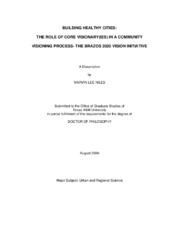| dc.description.abstract | The purpose of this study is to explore the role of social entrepreneurs or core visionaries in generating conceptual, financial, and community support and acceptance for a Healthy City/Community initiative in the Bryan/College Station area. This initiative affords all community members the opportunity to participate in long-term regional goals. Crucial questions were: what criteria were seen as beneficial to the community that would garner support to proceed with a Healthy City initiative, what would be desirable and more feasible - to enter into an agreement with an existing entity, an existing medical health provider, related entity or subsidiary, or to set up a new, independent entity to oversee the initiative, where would funding come from, what was the time commitment, and who would evaluate the initiative's success? Another purpose of this study is to explore how a Healthy City's process was adapted and developed for use in the Brazos Valley and how the initial community leaders or initiative "champions" went about initiating and organizing the movement, including identifying manpower needs, whether through the use of volunteers or the hiring of professionals, consultants, or full time staff to coordinate the various activities. Also of interest were the criteria that the initiative's leaders would use to divide their Healthy City's agenda or potential goals into topical components to be studied and analyzed by community representatives for inclusion (or not) into the final, formal Vision Statement for the community for succeeding by 2020. This was a qualitative study; interviews and observations of meetings were the information gathering methods used. According to the results, most participants found their involvement meaningful and enjoyable, but they also feared that no actions would come from the goals set by the community. Areas for further research or investigation might include: subsequent phases enacted by the Brazos 2020 Vision, changes made in dealing with future options after the Final Report was completed or distributed, resulting funding opportunities and movement of key leaders after the Brazos Valley initiative had entered subsequent phases. Another focus might be to continue to research or investigate the timeline for Brazos 2020 Vision up to the year 2020. | en |


